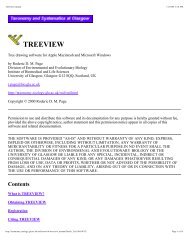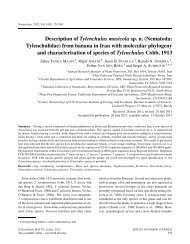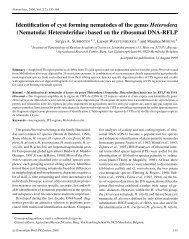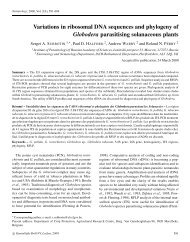Madina Rasulova Molecular Systematics of Nematodes Page 1
Madina Rasulova Molecular Systematics of Nematodes Page 1
Madina Rasulova Molecular Systematics of Nematodes Page 1
Create successful ePaper yourself
Turn your PDF publications into a flip-book with our unique Google optimized e-Paper software.
INTRODUCTION<br />
<strong>Nematodes</strong> belonging to the genus <strong>of</strong> Belonolaimus – also known as sting nematodes – are<br />
economically important ectoparasites <strong>of</strong> corn causing severe damage by trimming the lateral roots <strong>of</strong> corn<br />
seedlings even if their number is as low as 1-10 per 100 CC <strong>of</strong> soil. Belonolaimus longicaudatus has a<br />
wide host range including vegetables (e.g., beans, carrot, corn, crucifers, potato), fruits (e.g., citrus,<br />
strawberry), agronomic crops (e.g., cotton, peanut, sorghum, soybean), turfgrasses (e.g., bermudagrass, St.<br />
Augustinegrass, zoysiagrass) and forest crops (pine trees). Currently nine species <strong>of</strong> this genus (Table 1)<br />
are recognized (Fortuner and Luc, 1987).<br />
Table 1. The list <strong>of</strong> species belonging to the genus Belonolaimus.<br />
№ Species <strong>of</strong> genus Belomolaimus Authors<br />
1 Belonolaimus anama (Monteiro and Lordello, 1977) Fortuner and Luc, 1987<br />
2 Belonolaimus euthychilus Rau, 1963<br />
3 Belonolaimus gracilis Steiner, 1949<br />
4 Belonolaimus jara (Monteiro and Lordello, 1977) Fortuner and Luc, 1987<br />
5 Belonolaimus lineatus Roman, 1964<br />
6 Belonolaimus lolii Siviour, 1978<br />
7 Belonolaimus longicaudatus Rau, 1958<br />
8 Belonolaimus maritimus Rau, 1963<br />
9 Belonolaimus nortoni Rau, 1963<br />
Sting nematodes are relatively large worms (between 1.0 – 3.0 mm). B.longicaudatus (Table 2)<br />
possesses such characteristics as long, slender stylet <strong>of</strong> which cone constitutes 70-80% <strong>of</strong> the total stylet<br />
length (Fig. 1, A), oesophageal glands overlapping beginning <strong>of</strong> intestine, female tail cylindroid with a<br />
broadly rounded terminus, lateral fields (Fortuner and Luc, 1987). These worms are widely distributed in<br />
<strong>Madina</strong> <strong>Rasulova</strong> <strong>Molecular</strong> <strong>Systematics</strong> <strong>of</strong> <strong>Nematodes</strong> <strong>Page</strong> 2
















